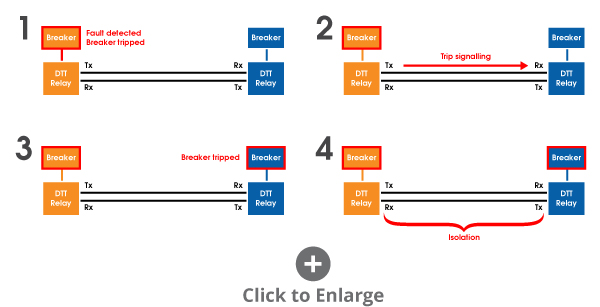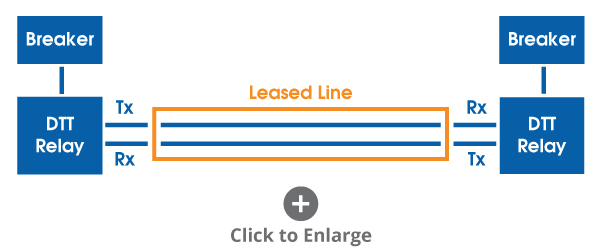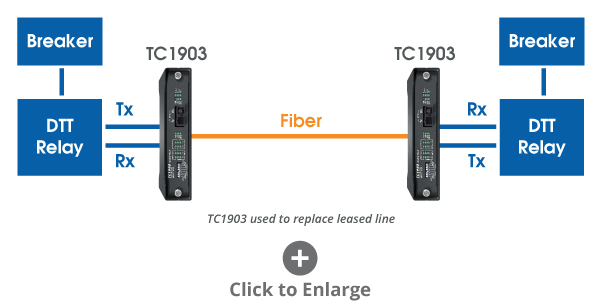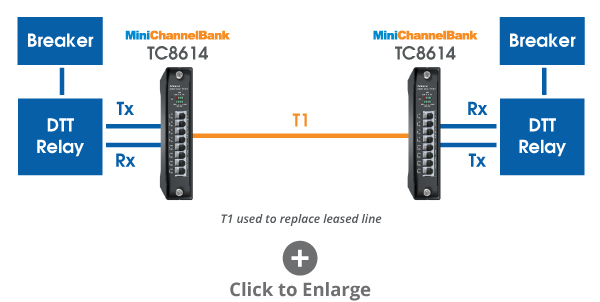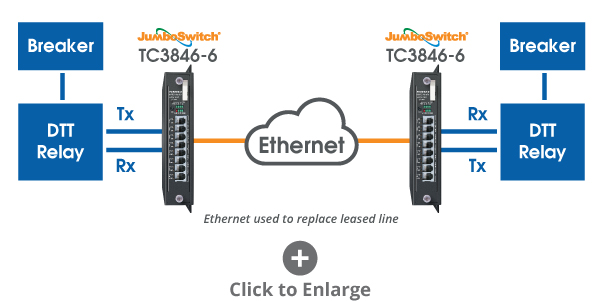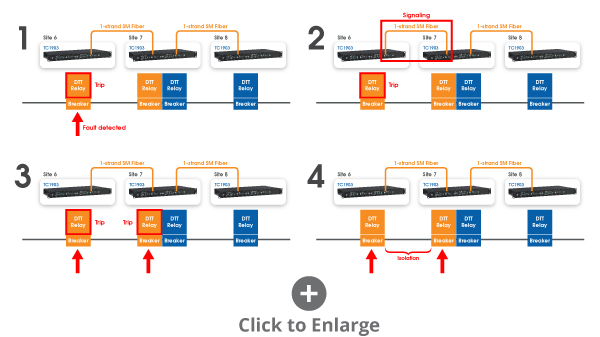Direct Transfer Trip (DTT) is a teleprotection scheme that involves sending trip signals from one location to another via a telecommunications transport, such as a phone line, radio, or fiber optics. It is commonly used for substations to detect substation faults and create lines of isolation while the faults are under investigation.
Because DTT signals have commonly been carried over leased telephone lines, many customers in industries such as utility and railway seek alternative DTT solutions as telecom providers either discontinue their leased line services or dramatically raise their prices to keep them.
In this application note, we explore three simple, drop-in solutions as a replacement for leased telephone lines in DTT systems, providing more cost-effective and reliable connectivity.
DTT Over a Leased Telephone Line (Conventional Method)
In this Direct Transfer Trip setup, a DTT relay is installed at both ends of a leased telephone line. The DTT relays are also each connected to circuit breakers, usually via fiber or pilot wire. This is represented by the diagram seen here:
In simple terms, when the DTT relay on the left (for example) detects a fault occurring within the substation, it trips the circuit breaker on the right (shown in blue). At the same time, it transmits a signal to the DTT relay on the right (shown in blue), which trips the circuit breaker on the left (shown in orange), creating a line of isolation between the two circuit breakers (shown in black).
When connecting the DTT relays over a leased telephone line, the setup might be represented as follows:
The leased line passes analog tones that ensure the DTT relays isolate the section of line with a fault present.
Three Alternative Solutions to Using Leased Lines
In situations where customers are looking to replace their leased lines or a leased line is otherwise unavailable, there are alternative solutions that TC Communications can provide. The three most common alternative transport methods for DTT are:
- Fiber
- T1/E1
- Ethernet
For these three methods, we use three main products for connecting over fiber, T1, and Ethernet, respectively:
TC1903: This Fiber Optic Phone/Analog Extender (with Bidirectional Single Fiber)* comes in a small, modem-sized form factor and extends analog and POTS telephone service to remote sites, in this case serving as an analog extender. It extends a 600 Ohm two- or four-wire line over fiber and is compatible with most PBXs or Key Systems.
*The TC1901 can be used in place of the single-fiber TC1903 for applications using dual fiber.
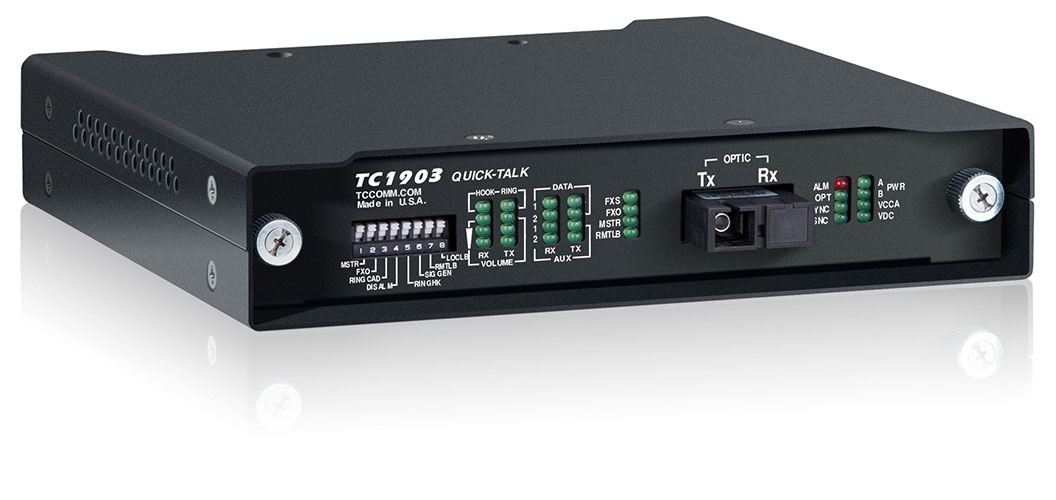
TC8614: This 4 Channel 600 Ohm Analog and Dry Contact-over-T1/E1 Multiplexer, part of our Mini Channel Bank family, is typically used to link or extend various 600 Ohm analog, audio, and intercom devices (e.g. FSK modems, E&M, teleprotection relay controllers, etc.), and dry contacts over existing T1/ E1 links. It is also used as a backup network to ensure business continuity.
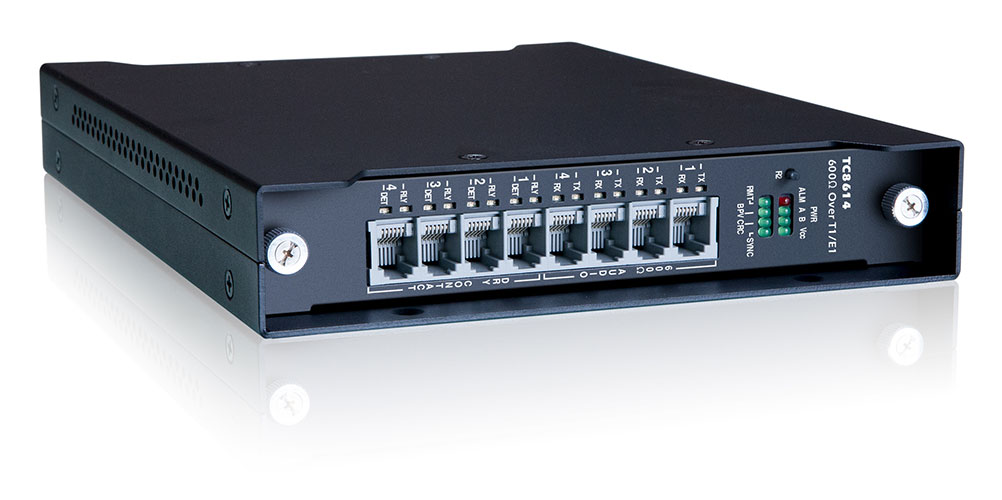
TC3846-6: This 2W/4W E&M 600 Ohm over IP Gateway is one of our most popular JumboSwitch® products. It links or extends up to four channels of 600 Ohm 2 or 4-wire analog and dry contacts across Layer 2/3 Ethernet/IP, CE, or MPLS networks.
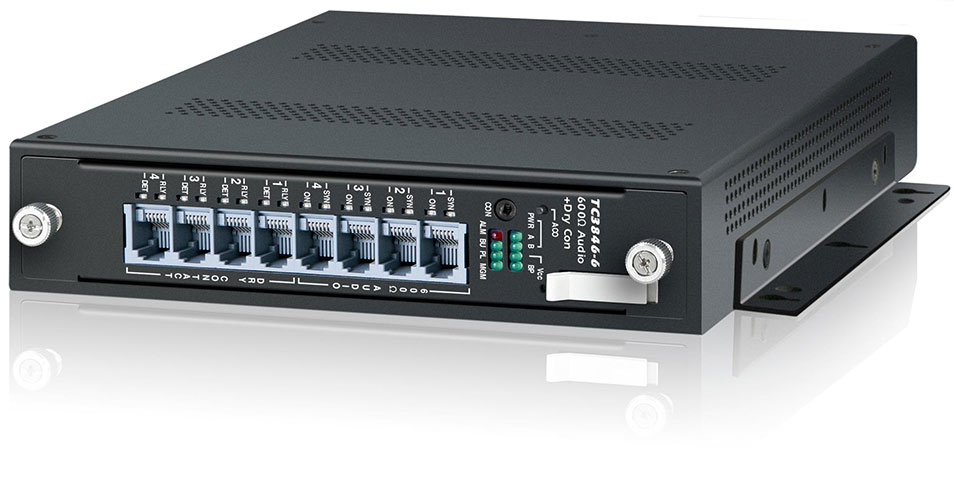
Next, we will take a look at three similar drop-in replacement solutions for DTT using these products.
Connecting Over Fiber Using the TC1903
In this application, a leased line is replaced by two TC1903 cards that are connected via single bi-directional fiber.
The DTT relays on each end connect to the TC1903 cards via the typical transmit and receive ports. With this setup, the DTT relays operate exactly as they would if they were still connected to a four-wire analog or leased line circuit, providing a fast and reliable means of transmitting and receiving DTT signals to trip the circuit breakers when a fault is detected.
For customers that have the capability or preference to use dual fiber instead of single fiber, the exact same effect can be achieved using two TC1901 cards instead.
Connecting Over T1 Using the TC8614
In this application, in place of a leased line, two TC8614 cards connected over a T1 line. It is another drop-in replacement that functions in much the same way as the TC1903 application over fiber.
Each DTT relay connects to a TC8614 card via the Tx and Rx ports, enabling fast and reliable transmission and receiving of DTT signals when a fault is detected, tripping both circuit breakers and creating an isolated line between them.
Many telecom providers discontinuing their leased lines, such as Verizon and AT&T, are now offering T1 services as a generally lower-cost alternative. When T1 lines are available, the TC8614 can seamlessly provide the solution.
Connecting Over Ethernet Using the TC3846-6
In this application, two TC3856-6 JumboSwitch cards are connected over Ethernet/IP to extend a circuit between two DTT relays.
Each DTT relay connects to a TC3846-6 card via the Tx and Rx ports, enabling it to transmit and receive DTT signals to and from the other relay. One, two, or four channels may be used over 2 or 4-wire analog over Ethernet.
This is an excellent choice for sites where Ethernet connectivity is already present and due to the JumboSwitch connecting with extremely low latency, it is fully compatible with all DTT applications.
A Customer Example
A major greater Chicago metropolitan transit organization needed to connect DTT relays between the sites.
To achieve this, we installed a pair of TC1903 cards at each site (26 total) and connected them via 12 strands of single-mode fiber to link the 13 sites together in a chain fashion. (For illustration purposes, only three sites will be shown in the diagram below).
Let's take a look at three of their sites and how they work. We have a power line with breakers providing power to transit locomotives between site six and seven.
We have a single strand of fiber connecting two DTT relays via two TC1903s. If the breaker at site 6 is triggered, the signal will reach the breaker at site 7 over fiber and cause an isolation.
The same event can occur only between site 7 and 8 and so on.
Conclusion
With average leased line costs exceeding $1,500 a month and even as high as $10,000 a month, more customers are seeking alternative solutions for Direct Transfer Trip applications. The three solutions covered here over dedicated dark fiber, T1, and Ethernet connectivity provide customers with the flexibility to use what is available to them or reduce costs through leased line replacement.
Each of the TC Communications products used in these solutions is covered by a five-year warranty and available in an extreme temperature version with an operating range between -40 to 80 degrees Celsius (-40 to 176 degrees Fahrenheit), making them ideal for withstanding harsh weather conditions, helping to maintain reliable in DTT teleprotection.
Related
Interested in similar content? Subscribe to our mailing list.
